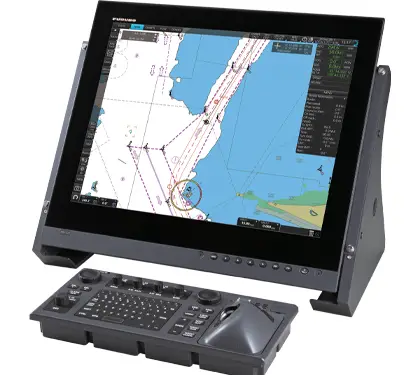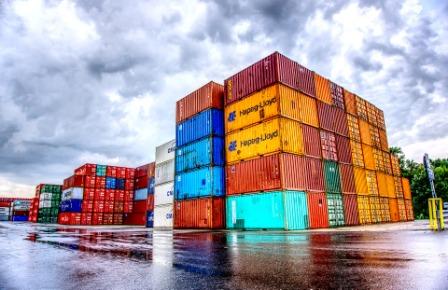PERFORMANCE STANDARDS FOR ELECTRONIC CHART DISPLAY AND INFORMATION SYSTEMS (ECDIS)
- The primary function of the ECDIS is to contribute to safe navigation.
- ECDIS with adequate backup arrangements may be accepted as complying with the up-to-date charts required by regulation V/20 of the 1974 SOLAS Convention.
- In addition to the general requirements for shipborne radio equipment forming part of the global maritime distress and safety system (GMDSS) and for electronic navigational aids contained in IMO resolution A.694 (17) *, ECDIS should meet the requirements of this performance standard.
- ECDIS should be capable of displaying all chart information necessary for safe and efficient navigation originated by and distributed on the authority of, the government authorized hydrographic offices.
- ECDIS should facilitate simple and reliable updating of the electronic navigational
chart. - ECDIS should reduce the navigational workload compared to using the paper chart. It should enable the mariner to execute in a convenient and timely manner all route planning, route monitoring and positioning currently performed on paper charts. It should be capable of continuously plotting the ship’s position.
- ECDIS should have at least the same reliability and availability of presentation as the paper chart published by government authorized hydrographic offices.
- ECDIS should provide appropriate alarms or indications with respect to the information displayed or malfunction of the equipment (see Appendix 5).
DEFINITIONS
- Electronic Chart Display and Information System (ECDIS) means a navigation
an information system which with adequate backup arrangements can be accepted as
complying with the up-to-date chart required by regulation V/20 of the 1974 SOLAS
Convention, by displaying selected information from a system electronic navigational chart
(SENC) with positional information from navigation sensors to assist the mariner in route
planning and route monitoring, and if required display additional navigation-related
information. - Electronic Navigational Chart (ENC) means the database, standardized as to content, structure, and format, issued for use with ECDIS on the authority of government authorized hydrographic offices. The ENC contains all the chart information necessary for safe navigation and may contain supplementary information in addition to that contained in the paper chart (e.g. sailing directions) which may be considered necessary for safe navigation.
- System Electronic Navigational Chart (SENC) means a database resulting from the transformation of the ENC by ECDIS for appropriate use, updates to the ENC by appropriate means and other data added by the mariner. It is this database that is actually accessed by ECDIS for the display generation and other navigational functions and is the equivalent to an up-to-date paper chart. The SENC may also contain information from other sources.
- Standard Display means the SENC information that should be shown when a chart is first displayed on ECDIS. Depending upon the needs of the mariner, the level of the information it provides for route planning or route monitoring may be modified by the mariner.
- Display Base means the level of SENC information which cannot be removed from the display, consisting of information which is required at all times in all geographic areas and all circumstances. It is not intended to be sufficient for safe navigation.
DISPLAY OF SENC INFORMATION
- ECDIS should be capable of displaying all SENC information.
- SENC information available for display during route planning and route monitoring should be subdivided into the following three categories, Display Base, Standard Display and All Other Information.
- ECDIS should present the Standard Display at any time by a single operator action.
- When a chart is first displayed on ECDIS, it should provide the Standard Display at the largest scale available in the SENC for the displayed area.
- It should be easy to add or remove information from the ECDIS display. It should not be possible to remove information contained in the Display Base.
- It should be possible for the mariner to select a safety contour from the depth contours provided by the SENC. ECDIS should emphasize the safety contour over other contours on the display.
- It should be possible for the mariner to select a safety depth. ECDIS should emphasize soundings equal to or less than the safety depth whenever spot soundings are selected for display.
- The ENC and all updates to it should be displayed without any degradation of their information content.
- ECDIS should provide a method to ensure that the ENC and all updates to it have been correctly loaded into the SENC.
- The ENC data and updates to it should be clearly distinguishable from other displayed information, such as, for example, that listed in Appendix 3.
PROVISION AND UPDATING OF CHART INFORMATION
- The chart information to be used in ECDIS should be the latest edition of that originated by a government authorized hydrographic office, and conform to IHO standards.
- The contents of the SENC should be adequate and up-to-date for the intended voyage to comply with regulation V/20 of the 1974 SOLAS Convention.
- It should not be possible to alter the contents of the ENC.
- Updates should be stored separately from the ENC.
- ECDIS should be capable of accepting official updates to the ENC data provided in conformity with IHO standards. These updates should be automatically applied to the SENC. By whatever means updates are received, the implementation procedure should not interfere with the display in use.
- ECDIS should also be capable of accepting updates to the ENC data entered manually
with simple means for verification prior to the final acceptance of the data. They would be
distinguishable on the display from ENC information and its official updates and not affect display legibility. - ECDIS should keep a record of updates including time of application to the SENC.
- ECDIS should allow the mariner to display updates in order to review their contents and to ascertain that they have been included in the SENC.
SCALE
ECDIS should provide an indication if:
- the information is displayed at a larger scale than that contained in
the ENC; or - own ship’s position is covered by an ENC at a larger scale than
that provided by the display.
DISPLAY OF OTHER NAVIGATIONAL INFORMATION
- Radar information or other navigational information may be added to the ECDIS display. However, it should not degrade the SENC information and it should be clearly distinguishable from the SENC information.
- ECDIS and added navigational information should use a common reference system. If this is not the case, an indication should be provided.
- Radar
1 Transferred radar information may contain both the radar image and ARPA information.
2 If the radar image is added to the ECDIS display, the chart and the radar image should match in scale and in orientation.
3 The radar image and the position from the position sensor should both be adjusted automatically for antenna offset from the conning position.
4 It should be possible to adjust the displayed position of the ship manually so that the radar image matches the SENC display.
5 It should be possible to remove the radar information by single operator action.
DISPLAY MODE AND GENERATION OF THE NEIGHBOURING AREA
- It should always be possible to display the SENC in a “north-up” orientation. other orientations are permitted.
- ECDIS should provide for true motion mode. Other modes are permitted.
- When true motion mode is in use, reset and generation of the neighboring area should take place automatically at a distance from the border of the display determined by the mariner.
- It should be possible to change manually the chart area and the position of own ship relative to the edge of the display.
COLOURS AND SYMBOLS
- IHO recommend colours and symbols should be used to represent SENC information.
- The colours and symbols other than those mentioned in 8.1 should be those used to describe the navigational elements and parameters listed in Appendix 3 and published by
- SENC information when displayed at the scale specified in the ENC should use the specified size of symbols, figures, and letters.
- ECDIS should allow the mariner to select whether own ship is displayed in true scale or as a symbol.
DISPLAY REQUIREMENTS
- ECDIS should be capable of displaying information for:
1 route planning and supplementary navigation tasks;
2 route monitoring. - The effective size of the chart presentation for route monitoring should be at least 270
mm by 270 mm. - The display should be capable of meeting colour and resolution recommendations of
IHO. - The method of presentation should ensure that the displayed information is clearly
visible to more than one observer in the conditions of light normally experienced on the
bridge of the ship by day and by night.
ROUTE PLANNING, MONITORING, AND VOYAGE RECORDING
- It should be possible to carry out route planning and route monitoring in a simple and reliable manner.
- ECDIS should be designed following ergonomic principles for user-friendly operation.
- The largest scale data available in the SENC for the area given shall always be used by the ECDIS for all alarms or indications of crossing the ship’s safety contour and of entering a prohibited area, and for alarms and indications.
- Route Planning
1 It should be possible to carry out route planning including both straight and curved segments.
2 It should be possible to adjust a planned route by, for example:
a) adding waypoints to a route;
b( deleting waypoints from a route;
c) changing the position of a waypoint;
d) changing the order of the waypoints in the route.
3 It should be possible to plan an alternate route in addition to the selected route. The selected route should be clearly distinguishable from the other route.
4 An indication is required if the mariner plans a route across an own ship’s safety contour.
5 An indication is required if the mariner plans a route across the boundary of a prohibited area or a geographic area for which special conditions exist.
6 It should be possible for the mariner to specify a limit of deviation from the planned route at which activation of an automatic offtrack alarm should occur. - Route monitoring
1 For route monitoring, the selected route and own ship’s position should appear whenever the display covers that area.
2 It should be possible to display a sea area that does not have the ship on the display (e.g. for a look ahead, route planning), while route monitoring. If this is done on the display used for route monitoring, the automatic route monitoring functions (e.g. updating ship’s position, and providing alarms and indications) should be continuous. It should be possible to return to the route monitoring display covering own ship’s position immediately by single operator action.
3 ECDIS should give an alarm if, within a specified time set by the mariner, own ship will cross the safety contour.
4 ECDIS should give an alarm or indication, as selected by the mariner if, within a specified time set by the mariner, own ship will cross the boundary of a prohibited area or of a geographical area for
which special conditions exist.
5 An alarm should be given when the specified limit for deviation from the planned route is exceeded.
6 The ship’s position should be derived from a continuous positioning system of an accuracy consistent with the requirements of safe navigation. Whenever possible, a second independent positioning method of a different type should be provided; ECDIS should be capable of identifying discrepancies between the two systems.
7 ECDIS should provide an indication when the input from the position fixing system is lost. ECDIS should also repeat, but only as an indication, any alarm or indication passed to it from a position
fixing system.
8 An alarm should be given by ECDIS if the ship, within a specified time or distance set by the mariner, will reach a critical point on the planned route.
9 The positioning system and the SENC should be on the same geodetic datum. ECDIS should give an alarm if this is not the case.
10 It should be possible to display an alternative route in addition to the selected route. The selected route should be clearly distinguishable from the other routes. During the voyage, it should be possible for the mariner to modify the selected sailing route or change to an alternative route.
11 It should be possible to display:
a) time-labels along ships track manually on demand and automatically at intervals selected between 1 and 120 minutes; and
b) an adequate number of points, free movable electronic bearing lines, variable and fixed range markers and other symbols required for navigation purposes.
12 It should be possible to enter the geographical coordinates of any position and then display that position on demand. Also, it should be possible to select any point (features, symbol or position) on
the display and read it’s geographical coordinates on demand.
13 It should be possible to adjust the ship’s geographic position manually. This manual adjustment should be noted alpha-numerically on the screen, maintained until altered by the mariner and
automatically recorded. - Voyage recording
1 ECDIS should store and be able to reproduce certain minimum elements required to reconstruct the navigation and verify the official database used during the previous 12 hours. The following
data shall be recorded at one-minute intervals:
a( to ensure a record of own ship’s past track: time, position, heading, and speed; and
b) to ensure a record of official data used: ENC source, edition, date, cell and update history.
2 In addition, ECDIS should record the complete track for the entire voyage, with time marks at intervals not exceeding 4 hours.
3 It should not be possible to manipulate or change the recorded information.
4 ECDIS should have a capability to preserve the record of the previous 12 hours and of the voyage track.
ACCURACY
- The accuracy of all calculations performed by ECDIS should be independent of the characteristics of the output device and should be consistent with the SENC accuracy.
- Bearings and distances drawn on the display or those measured between features already drawn on the display should have an accuracy no less than that afforded by the
resolution of the display.
CONNECTIONS WITH OTHER EQUIPMENT *
- ECDIS should not degrade the performance of any equipment providing sensor inputs. Nor should the connection of optional equipment degrade the performance of ECDIS below this standard.
- ECDIS should be connected to systems providing continuous position fixing, heading and speed information.
PERFORMANCE TESTS, MALFUNCTIONS ALARMS, AND INDICATIONS
- ECDIS should be provided with means for either automatically or manually carried out onboard tests of major functions. In case of a failure, the test should display information to indicate which module is at fault.
- ECDIS should provide a suitable alarm or indication of system malfunction.
BACK-UP ARRANGEMENTS
- Adequate backup arrangements should be provided to ensure safe navigation in case of an ECDIS failure.
1 Facilities enabling a safe take-over of the ECDIS functions should be provided to avoid that an ECDIS failure develops into a critical situation.
2 A backup arrangement should be provided facilitating means for safe navigation of the remaining part of the voyage in case of an ECDIS failure.
POWER SUPPLY
- It should be possible to operate ECDIS and all equipment necessary for its normal functioning when supplied by an emergency source of electrical power in accordance with the appropriate requirements of chapter II-1 of the 1974 SOLAS Convention.
- Changing from one source of power supply to another or any interruption of the supply for a period of up to 45 seconds should not require the equipment to be manually reinitialized.





To know IMO requirements for navigational equipments